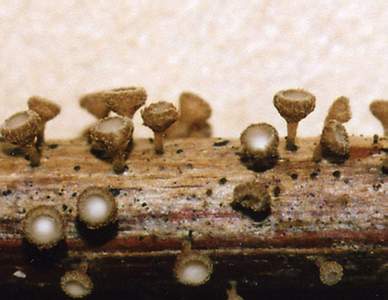Brunnipila hidden (Brunnipila clandestina)
- Matagaluega: Ascomycota (Ascomycetes)
- Vaevaega: Pezizomycotina (Pezizomycotins)
- Vasega: Leotiomycetes (Leociomycetes)
- Vasega laiti: Leotiomycetidae (Leocyomycetes)
- Poloaiga: Helotiales (Helotiae)
- Family: Hyaloscyphaceae (Hyaloscyphaceae)
- Genus: Brunnipila
- ituaiga: Brunnipila clandestina (Brunnipila hidden)

Author of the photo: Evgeny Popov
faamatalaga:
Fruit bodies scattered over the substrate, often numerous, small, 0.3-1 mm in diameter, cup-shaped or goblet-shaped, on a relatively long (up to 1 mm) stem, brown on the outside, covered with fine brown hairs, often with a whitish bloom, especially along the edge. Disc whitish, cream or pale yellow.
Asci 40-50 x 4.5-5.5 µm, club-shaped, with an amyloid pore, interspersed with lanceolate, strongly protruding paraphyses.
Spores 6-8 x 1.5-2 µm, unicellular, ellipsoid to fusiform, colorless.
Faʻasalalau:
It bears fruit from March to October, sometimes later. Found on dead stems of raspberries.
Le tutusa:
Species of the genus Brunnipila are easily confused with basidiomycetes from the genus Merismodes, which have fruiting bodies similar in shape, size and color. However, the latter always grow on wood and form very dense clusters.
Iloiloga:
Edibility is not known. Due to its small size, it has no nutritional value.









